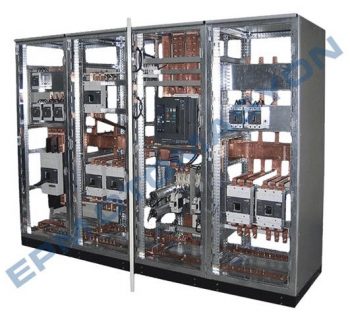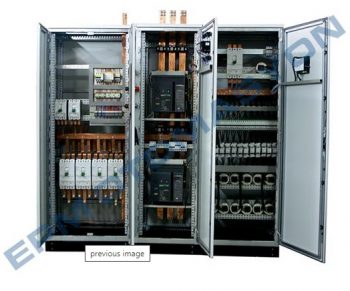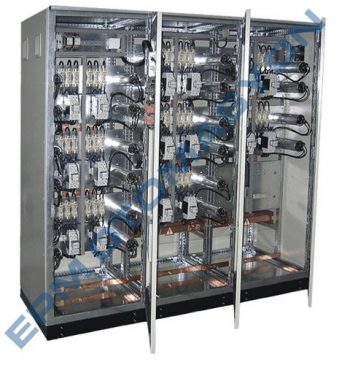COMPENSATION PANELS
Compansation Panels
In today’s electrical networks, a continuous increase in subscriber loads is constantly observed. Therefore, reactive loads increase over time, and the power coefficient of the grid decreases. Compensation is done to prevent this situation. Compensation methods adjust the phase difference between current and voltage to the most ideal angle, approaching reactive powers that negatively affect the system to zero. Thus, reactive power, which unnecessarily loads energy transmission lines and the grid, causing losses, is kept to a minimum level.
The logic behind compensation is to ensure that the reactive energy drawn by devices is generated from points close to the consumer. This way, the grid will not be unnecessarily burdened, and the capacity of the grid will be increased.
Compensation panels are used in compensation processes. This panel contains the devices, capacitors and measuring instruments required to regulate the power coefficient.
Compensation Benefits:
System Benefits of Compensation:
As a result of compensation, excess reactive power will not be carried in the system. Consequently;
- There will be a reduction in power losses in the grid.
- Since more active energy can be transmitted through the line, the capacity of production, transmission, and distribution systems increases, resulting in improved efficiency.
- The energy carrying capacity increases in lines where limited power is transported due to voltage drop.
- There will be a reduction in heat losses.
Benefits for the Electricity Producer:
- Conductors are selected with a smaller cross-section as they will carry less current.
- Since more active energy can be transmitted through the same transmission line, the capacity and efficiency of production, transmission, and distribution facilities increase.
- The cost of energy production and sales decreases.
- The power of alternators and transformers is kept smaller.
- There is a decrease in losses and voltage drop in distribution lines.
Benefits for the Electricity Consumer:
- Conductors are selected with a smaller cross-section.
- The supply transformer, control, and protection elements are selected with smaller values.
- The capacity and efficiency of the supply transformer and the facility increase.
- There is a decrease in losses and voltage drop.
- Less reactive power is drawn from the grid.
- Since the energy consumption decreases, the energy cost also decreases.
Why is Compensation Done?
If compensation is not carried out for any reason, losses occur in the grid, transmission lines, and cables draw much more current. Consequently, significant voltage drops follow. The energy carrying capacity decreases.
If there is excessive reactive power consumption in facilities and businesses, the power coefficient (Cos φ) decreases, and the facility operates below its nominal capacity; voltage drop and losses increase.
We can list the main problems caused by the low (cosθ) value, i.e., when the Reactive Power value is higher than the Active Power value, as follows:
- Transformer overheating.
- Reduction in operating lifespans.
- Full loading of transformers and generators, inability to add new loads.
- Voltage drop.
- Heating in cables.
- Reactive power penalty.
A person with the following conditions is obligated to implement compensation:
*It is mandatory to have a compensation system in electric facilities with installed power of 250 KVA and above.
*Three-phase industrial consumers should include compensation facilities in their projects.
*If consumers establish their own compensation facilities, it is sufficient to have only a fixed capacitor group in the transformers.
*Compensation must be done in compliance with regulations.
Compensation and Reactive Power Penalty
In ideal grid, a power coefficient of 1, meaning equal amounts of Reactive Power and Active Power, is desired. Since this is not the case in reality, compensation is performed to balance Reactive Power with Active Power (producing Reactive Power only as much as needed) in electrical networks, enabling the optimal utilization of the existing electrical energy system.
As of January 9, 2007, according to the “Regulation on Amendment of the Regulation on Customer Services in the Electricity Market” published in the Official Gazette, the limits for generating Reactive Power are as follows:
| Contracted Power: | Inductive | Capacitive |
| Less than 30 KW | %33 | %20 |
| Greater than 30KW | %20 | %15 |
If you exceed these limits, the penalty amount determined in the tariff will be reflected in your electricity bill. If you see charges in the inductive and capacitive columns other than the active column on your electricity bill, it represents the penalty amount imposed on you.
On the other hand, TEDAŞ recommends compensation with capacitor power between 5% and 10%, regardless of transformer power, to prevent inefficient energy use.
In order to free facilities from reactive power and operate facility elements at their full capacities, in short, to create an economical operation, it is appropriate to generate reactive power at consumption centers.
Our Solutions
- Automation Solutions
- Data Collection and IoT Solutions
- Augmented Reality (AR)
- MES-MOM Solutions
- Machine and Safety Automation
- Eccentric and Hydraulic Press Automation
- Transformer Fan Control Panels
- Transformer Tap Changer RTCC (AVR) Panel
- L.V Distribution and Lighting Panels
- Compensation Panels
- Motor Control (MCC) Panels
- Electric Meter Panels
- Electrical Project and Design
- Panel Manufacturing and Assembly



